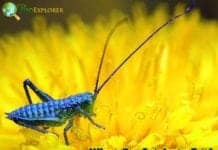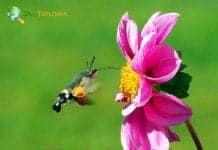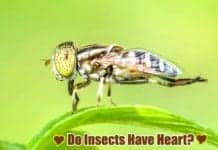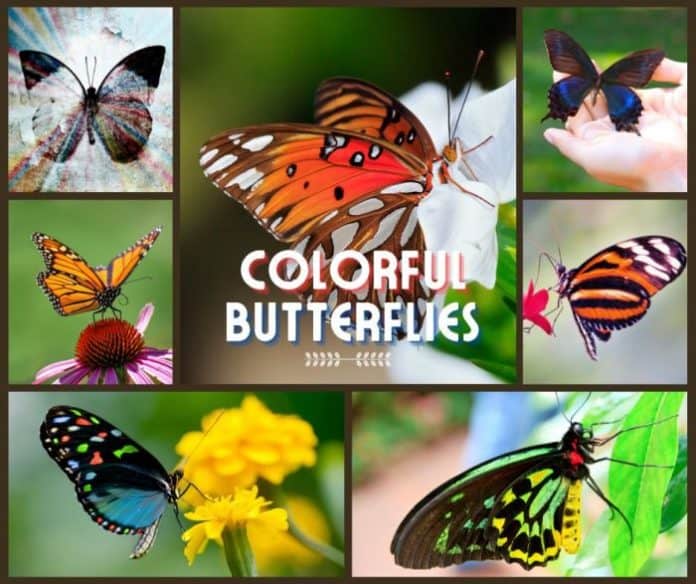
Butterflies are among the most enchanting creatures in the natural world, captivating humans with their delicate beauty and graceful flight. These incredible insects come in many colors, patterns, and sizes, each more stunning than the last. Colorful butterflies, in particular, have a special allure, their vibrant hues serving not only to dazzle the eye but also to play crucial roles in their survival and ecological importance.
On this page, we will embark on a fascinating journey to explore 25 of the most spectacular and colorful butterfly species from around the globe. From the iridescent blues of the Blue Morpho to the striking red and black of the Postman Butterfly, we will delve into the unique characteristics, behaviors, and habitats of these remarkable creatures.
As we uncover the secrets behind their colorful appearances, we will also shed light on their vital roles in our ecosystems. Butterflies are essential pollinators, helping to maintain the balance and diversity of plant life cycle in their habitats. They also serve as important indicators of environmental health, their presence or absence in an area reflecting the state of the ecosystem.
So, let us spread our wings and take flight into the world of colorful butterflies, marveling at their beauty and gaining a deeper appreciation for their significance in the tapestry of life on Earth.
Table of Contents
- Colorful Butterflies
- 1. Blue Morpho
- 2. Monarch Butterfly
- 3. Glasswing Butterfly
- 4. Emerald Swallowtail
- 5. Peacock Butterfly
- 6. Painted Lady
- 7. Ulysses Butterfly
- 8. Clipper Butterfly
- 9. Common Bluebottle
- 10. Zebra Longwing
- 11. Purple Emperor
- 12. Crimson Rose
- 13. Orange Oakleaf
- 14. Green Hairstreak
- 15. Malachite Butterfly
- 16. Great Orange Tip
- 17. Rajah Brooke’s Birdwing
- 18. Blue Tiger
- 19. Ceylon Rose
- 20. Scarlet Mormon
- 21. Glassy Tiger
- 22. Jewel Beetle Butterfly
- 23. Indian Red Admiral
- 24. Postman Butterfly
- 25. Green-banded Swallowtail
- Why Colorful Butterflies?
Colorful Butterflies
In the following sections, we will explore 25 spectacular, colorful butterfly species, each with its own unique characteristics, habitats, and ecological significance. By understanding and appreciating these remarkable creatures, we can better protect and conserve them, ensuring their beauty and importance continue to grace our world for generations.
1. Blue Morpho
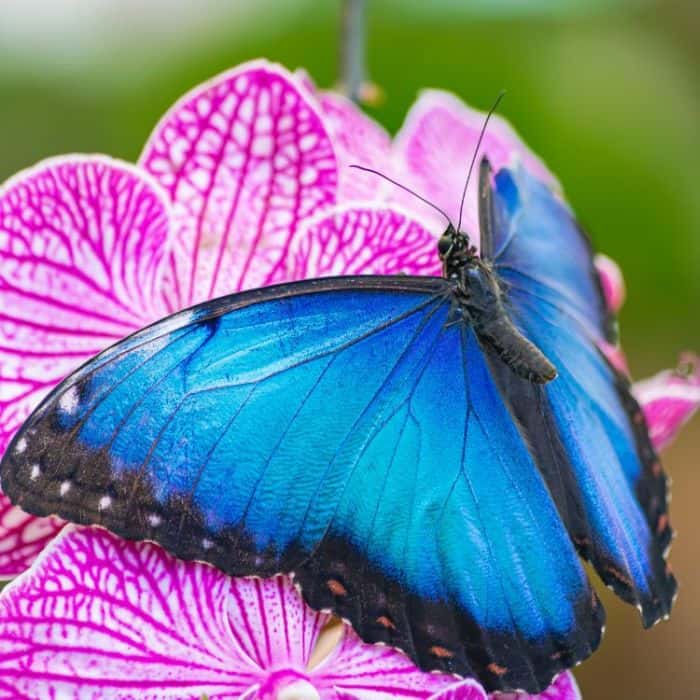
| Animalia | Lepidoptera | Nymphalidae | Morpho | Morpho peleides |
The Blue Morpho Butterfly, scientifically known as Morpho peleides, is one of the most recognizable and captivating butterflies found in the Tropical Rainforests of Central and South America.
This species is famous for its large, vivid blue wings, spaning up to six inches. The iridescent blue coloration is due to microscopic scales on the backs of their wings that reflect light, creating a stunning visual effect.
The Blue Morpho butterfly’s wings are predominantly an iridescent blue, resulting from light reflecting off microscopic scales. The edges of the wings are lined with black, and the undersides of the wings are brown with numerous eyespots designed for camouflage.
The combination of blue, black, and brown makes this butterfly both vibrant and effective in avoiding predators.
2. Monarch Butterfly
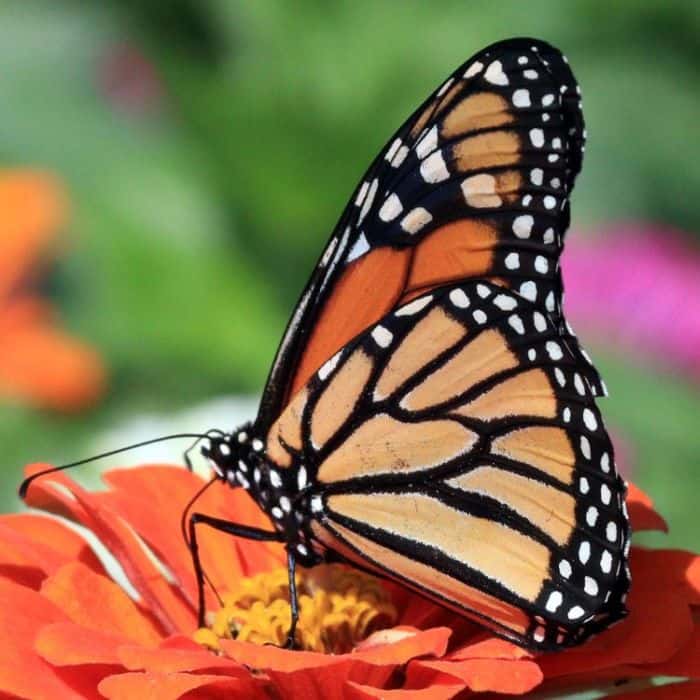
| Animalia | Lepidoptera | Nymphalidae | Danaus | Danaus plexippus |
The Monarch Butterfly, Danaus plexippus, is renowned for its striking appearance and extraordinary migratory behavior. It is native to North America but can also be found in other parts of the world due to its migratory patterns.
The Monarch Butterfly is easily recognizable by its bright orange wings with black borders and white spots.
The orange coloration is an aposematic signal to potential predators, warning them of the butterfly’s toxicity. The undersides of the wings are paler, providing camouflage when the butterfly is at rest.
The vibrant orange is due to the presence of ommochrome pigments, which have been well-studied for their role in coloration and signaling.
3. Glasswing Butterfly
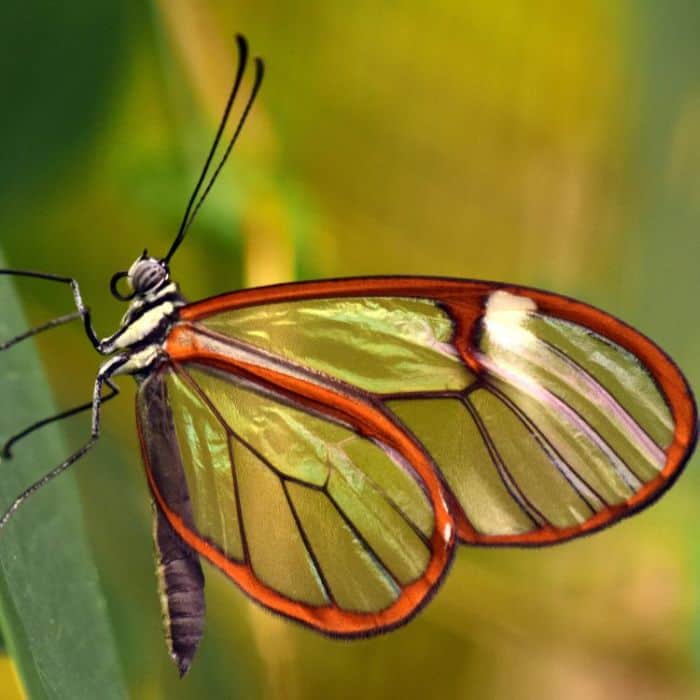
The Glasswing Butterfly, Greta oto, is a remarkable species known for its transparent wings, which make it one of the most unique and visually intriguing butterflies. It belongs to the family Nymphalidae and is predominantly found in Central America, from Mexico to Panama.
The wings of the Glasswing Butterfly are primarily transparent, with edges tinged with brown and white. This transparency is due to the presence of nanostructures that minimize light reflection. \
The transparency and subtle coloration make it an exceptional example of natural camouflage, effectively reducing its visibility to predators.
4. Emerald Swallowtail
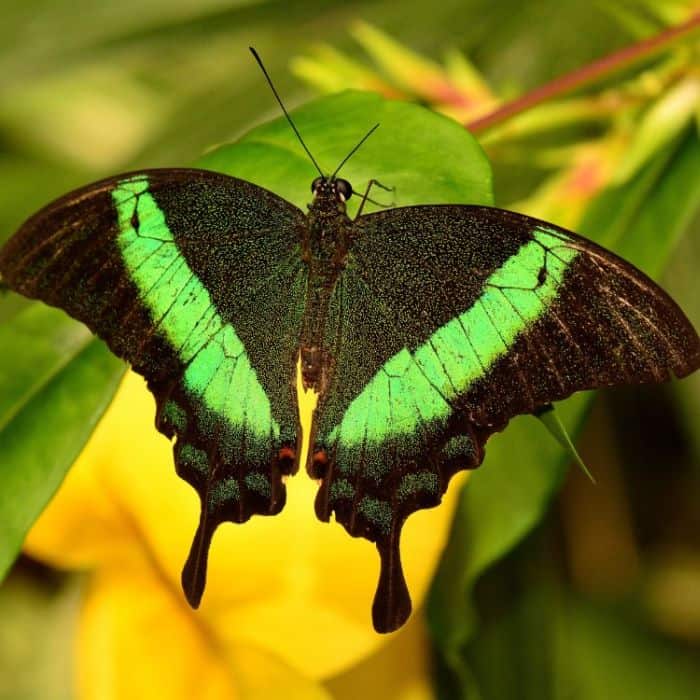
The Emerald Swallowtail, Papilio palinurus, is a dazzling butterfly species belonging to the family Papilionidae. It is primarily found in Southeast Asia, including regions such as the Philippines, Malaysia, and Indonesia.
Known for its striking iridescent green coloration, this butterfly is a popular subject of both scientific research and butterfly exhibits worldwide.
The wings of the Emerald Swallowtail are predominantly black, with vivid iridescent green bands and spots that shimmer under sunlight. The green coloration is due to microscopic structures on the scales that reflect light in a way that produces the vibrant, metallic green hue.
This structural coloration is visually stunning and serves as a mechanism for mate attraction and camouflage against predators.
5. Peacock Butterfly
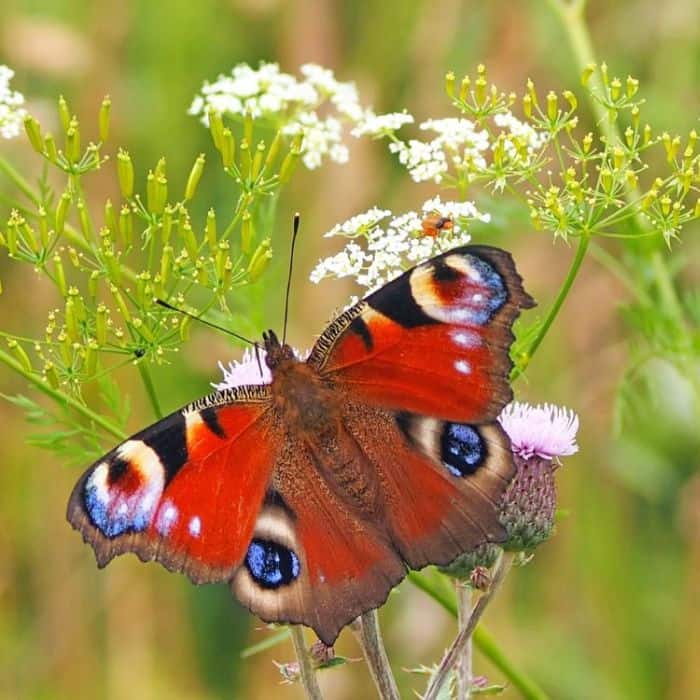
The Peacock Butterfly, Aglais io, is a widely recognized species within the Nymphalidae family, known for its stunning eyespot patterns on its wings. Native to Europe and temperate Asia, this butterfly is commonly found in Gardens, woodlands, and agricultural areas.
The wings of the Peacock Butterfly are predominantly reddish-brown with large, vivid eyespots on each of the forewings and hindwings. These eyespots are blue, yellow, and black, which resemble the eyes of predators and serve as a defense mechanism to startle or deter potential threats.
The underside of the wings is dark and cryptically colored, aiding in camouflage when the butterfly is at rest.
6. Painted Lady
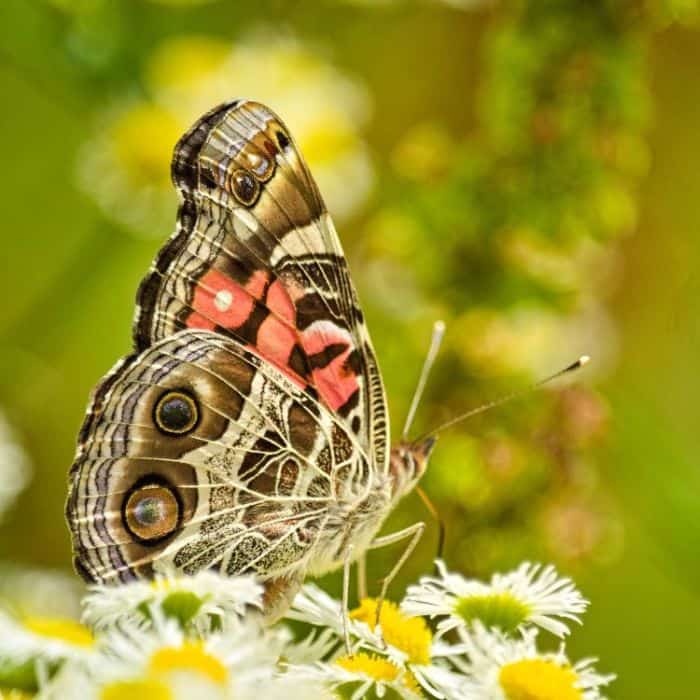
| Animalia | Lepidoptera | Nymphalidae | Vanessa | Vanessa cardui |
The Painted Lady, Vanessa cardui, is a cosmopolitan butterfly species found on every continent except Antarctica. Known for its striking orange and black wing patterns, this butterfly is one of the most widespread and well-studied species.
It is famous for its long-distance migratory behavior, involving multi-generational journeys between temperate breeding grounds and overwintering sites in subtropical and tropical areas.
The Painted Lady features orange wings with black spots and white markings on the forewings. The hindwings are speckled with brown, black, and blue spots.
This vibrant coloration serves both as camouflage when resting on flowers and as a warning signal to predators about its unpalatability, a result of feeding on toxic plants during its larval stage.
7. Ulysses Butterfly
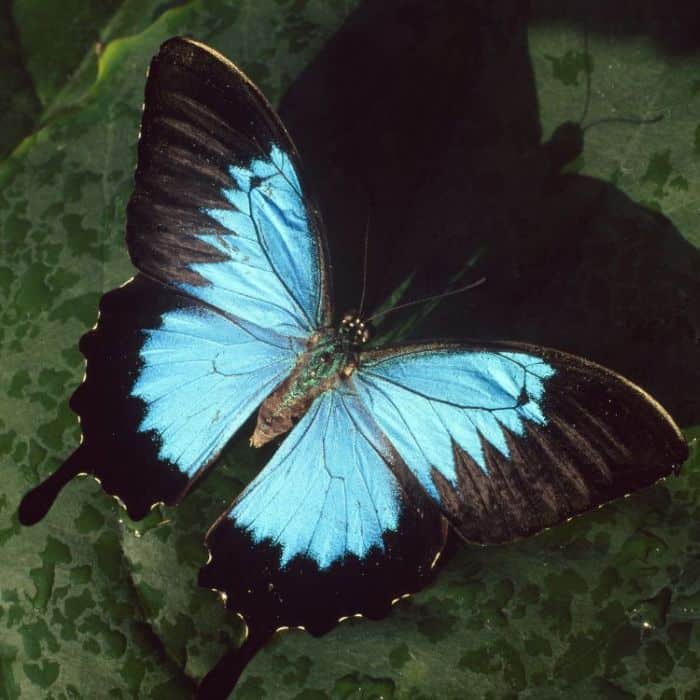
The Ulysses Butterfly, Papilio ulysses, also known as the Blue Mountain Swallowtail, is a large and striking butterfly found predominantly in northern Queensland, Australia, and in parts of Papua New Guinea and the Solomon Islands.
This butterfly is renowned for its vivid blue coloration and rapid flight, making it a popular species among butterfly enthusiasts and researchers.
The wings of the Ulysses Butterfly are a striking metallic blue on the upper side, with the iridescent color resulting from microscopic scales that reflect light. The undersides of the wings are dark brown to black, providing camouflage when the butterfly is at rest with its wings closed.
The blue coloration is due to the structural arrangement of the scales, which creates a vivid blue reflection when exposed to light.
8. Clipper Butterfly
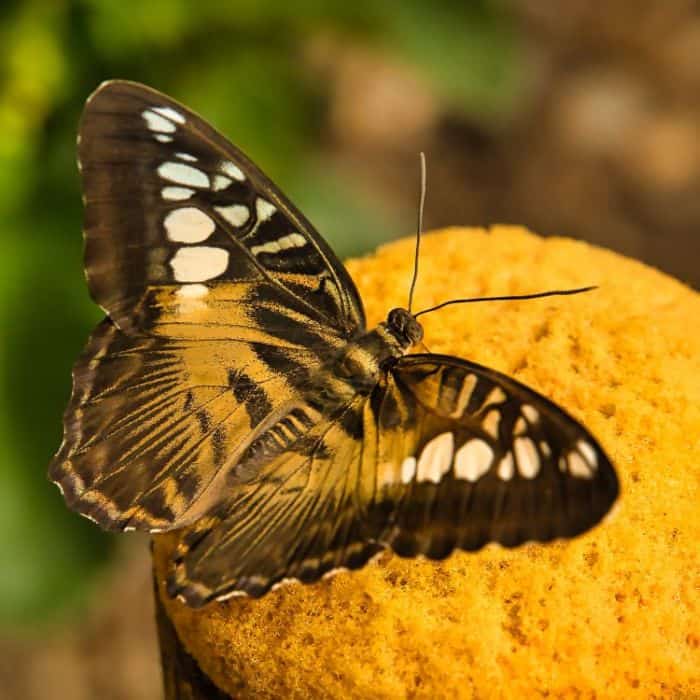
The Clipper Butterfly, Parthenos sylvia, is a striking butterfly species found in tropical and subtropical regions of Southeast Asia, including the Philippines, Malaysia, and parts of Indonesia.
This butterfly belongs to the family Nymphalidae, known for its rapid, gliding flight and vibrant wing patterns. The Clipper Butterfly is often seen in forests, gardens, and open areas where it can bask in the sunlight.
The wings of the Clipper Butterfly are predominantly dark brown with distinctive white and bluish-green markings. The forewings are adorned with large, irregular white patches and streaks, while the hindwings display white and blue-green patterns with a darker border.
This vibrant and contrasting coloration makes the Clipper Butterfly highly visible and aids in its identification.
9. Common Bluebottle
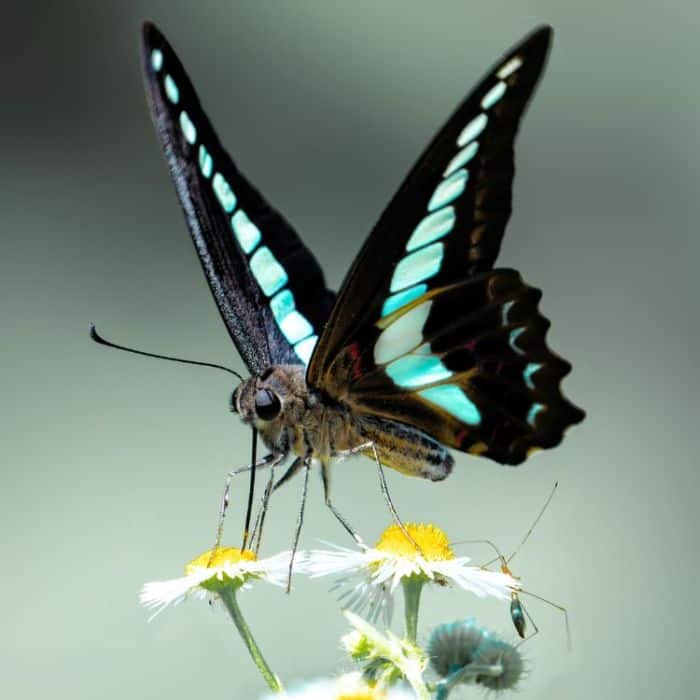
The Common Bluebottle, Graphium sarpedon, is a vibrant butterfly belonging to the Papilionidae family. It is widely distributed across South and Southeast Asia, as well as parts of Australia.
This species is known for its striking blue and black coloration and swift, agile flight.
The wings of the Common Bluebottle are a striking combination of black and iridescent blue-green.
The forewings are black with a prominent blue-green streak running through the middle, while the hindwings are similarly colored with additional blue-green markings.
This iridescence is due to specialized scales that reflect light in a way that creates vibrant coloration and helps in species recognition and mating.
10. Zebra Longwing
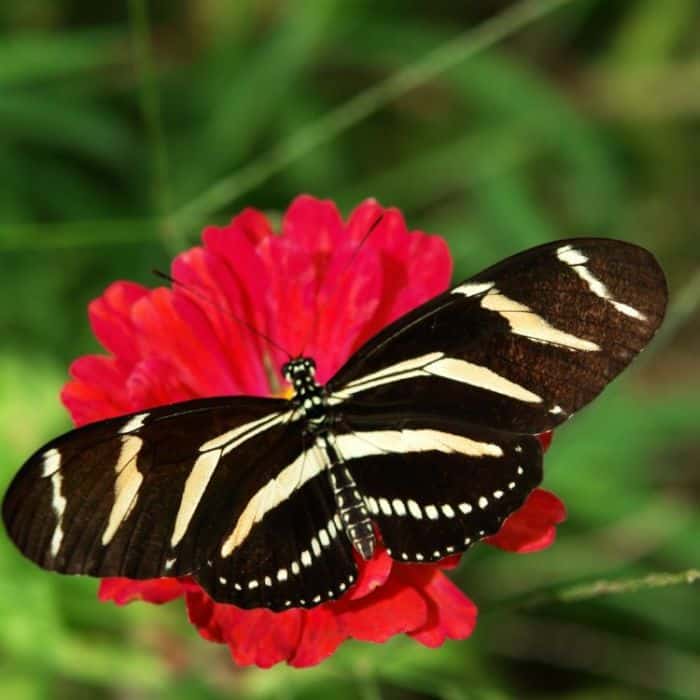
| Animalia | Lepidoptera | Nymphalidae | Heliconius | Heliconius charithonia |
The Zebra Longwing, Heliconius charithonia, is a notable butterfly species belonging to the Nymphalidae family. This colorful butterfly is widely distributed in the Americas, from the southern United States to South America.
Recognized for its elongated wings with bold black and yellow stripes, it is the state butterfly of Florida.
The wings of the Zebra Longwing are strikingly marked with alternating black and yellow stripes, which warn potential predators about their unpalatability.
The coloration is both a visual deterrent and a form of Müllerian mimicry, where it shares its color patterns with other toxic species to reinforce the avoidance behavior in predators.
11. Purple Emperor
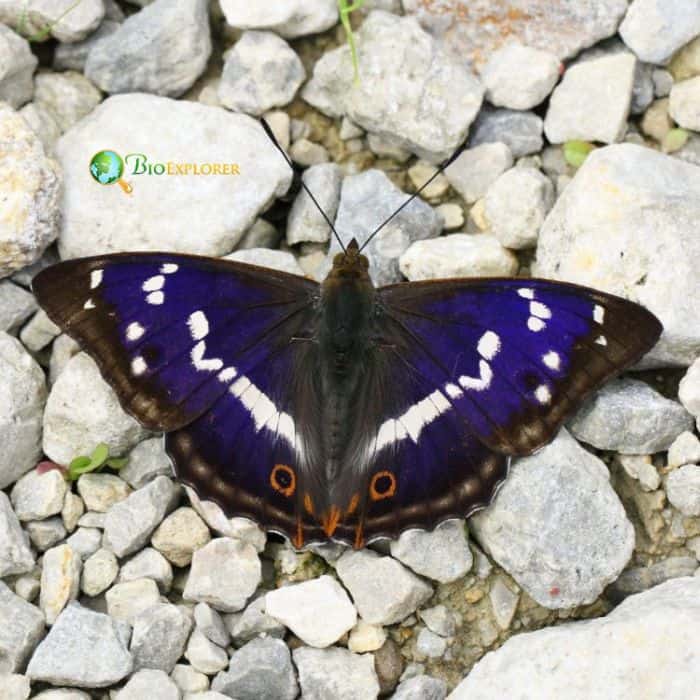
The Purple Emperor, Apatura Iris, is a magnificent butterfly species belonging to the Nymphalidae family. It is primarily found in the woodlands of Europe and parts of Asia.
Known for its iridescent purple sheen, the Purple Emperor is a subject of fascination among lepidopterists and nature enthusiasts.
The wings of the Purple Emperor are primarily dark brown with a stunning, iridescent purple-blue sheen visible when the light hits them at certain angles. This iridescence is caused by microscopic scales on the wings that reflect light.
The undersides of the wings are more subdued, featuring mottled patterns of brown and gray, which provide excellent camouflage against tree bark when the butterfly is at rest.
12. Crimson Rose
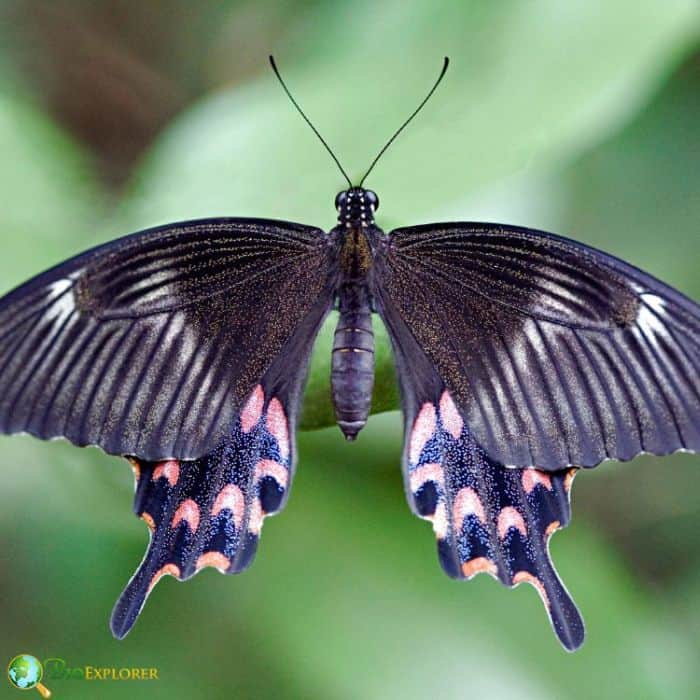
The Crimson Rose, Pachliopta hector, is a striking butterfly species belonging to the family Papilionidae. It is predominantly found in South India and Sri Lanka, thriving in tropical and subtropical environments.
Known for its vibrant coloration and graceful flight, this butterfly is a favorite among lepidopterists and nature enthusiasts.
The wings of the Crimson Rose are primarily black with bright red patches and white spots, creating a stunning contrast. The hindwings are adorned with large red spots bordered by white, while the forewings feature a series of smaller white spots.
This vivid coloration not only makes the butterfly visually striking but also warns predators about its unpalatability, which it gains from feeding on toxic host plants.
13. Orange Oakleaf
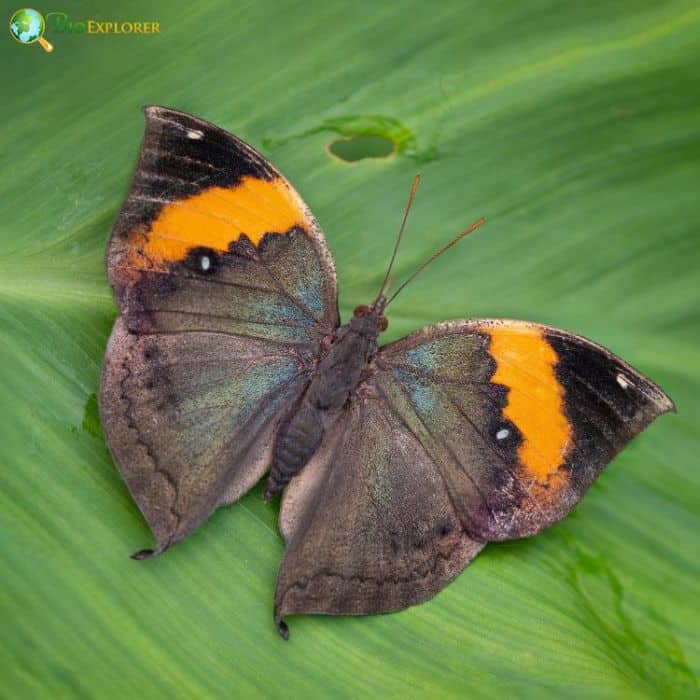
The Orange Oakleaf, Kallima inachus, is a remarkable butterfly known for its striking resemblance to a dead leaf, which serves as an effective camouflage. This species is found predominantly in tropical and subtropical regions of Southeast Asia, including India, Myanmar, and Malaysia.
The butterfly’s leaf mimicry is a classic example of protective resemblance, helping it evade predators by blending into its surroundings.
The dorsal side of the Orange Oakleaf’s wings is a bright, iridescent blue with orange and black patterns, while the ventral side is a mottled brown and gray, resembling a dead leaf.
This striking contrast in coloration between the wings’ upper and lower sides is crucial for camouflage and mate attraction.
14. Green Hairstreak
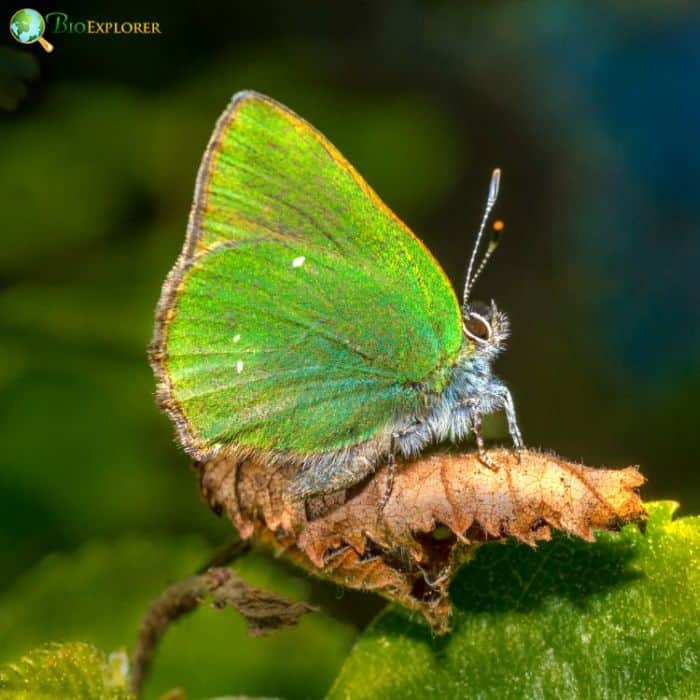
The Green Hairstreak, Callophrys rubi, is a small butterfly belonging to the Lycaenidae family. It is widely distributed across Europe, Asia, and North Africa, thriving in a variety of habitats, including heathlands, grasslands, and forest clearings.
This species is easily recognizable due to its vibrant green coloration, which serves both as camouflage and a warning signal to predators.
The wings of the Green Hairstreak are predominantly a bright, iridescent green on the underside, which provides excellent camouflage against green vegetation. The upper side of the wings is brown, typically only visible when the butterfly is in flight.
This striking green coloration is due to the gyroid nanostructures in the wing scales, which reflect light in a way that produces the vivid green hue.
15. Malachite Butterfly
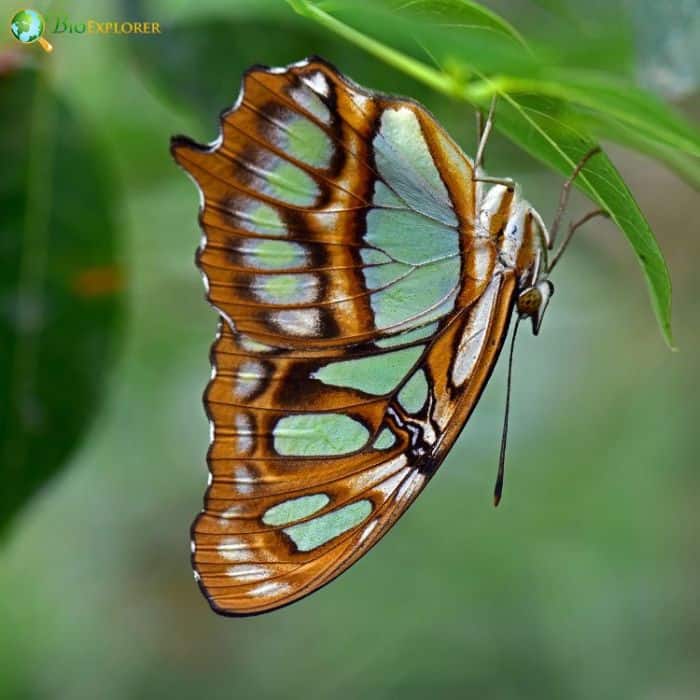
| Animalia | Lepidoptera | Nymphalidae | Siproeta | Siproeta stelenes |
The Malachite Butterfly, Siproeta stelenes, is a vibrant and captivating butterfly species belonging to the Nymphalidae family. This butterfly is predominantly found in Central and South America, ranging from Florida and Texas in the United States to parts of Brazil.
It thrives in tropical and subtropical habitats, including forests, gardens, and fields. The Malachite Butterfly is named for its striking green coloration, reminiscent of the mineral malachite.
The wings of the Malachite Butterfly are a vivid green with black and light brown markings. The upper side of the wings features a bright green background with bold black patches, while the underside is a paler green with intricate light brown and black patterns.
This combination of colors makes the Malachite Butterfly visually stunning and aids in camouflage against predators when it rests with its wings closed.
16. Great Orange Tip
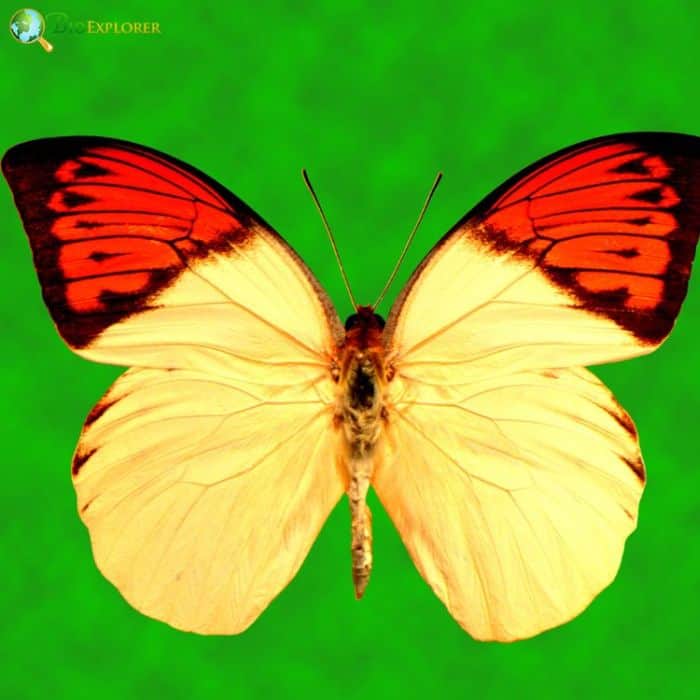
The Great Orange Tip, Hebomoia glaucippe, is a striking butterfly species belonging to the family Pieridae. It is widely distributed across South and Southeast Asia, including countries like India, Sri Lanka, China, Japan, and Malaysia.
This butterfly is known for its distinctive wing patterns and large size, making it easily recognizable.
The wings of the Great Orange Tip are predominantly white with bright orange tips on the forewings, bordered by black. The hindwings are white with subtle black spots along the margins.
The underside of the wings is a mix of brown and grey, which helps camouflage when the butterfly is at rest. This vibrant coloration, especially the contrasting orange and black on the forewings, makes the Great Orange Tip visually striking and easy to identify.
17. Rajah Brooke’s Birdwing
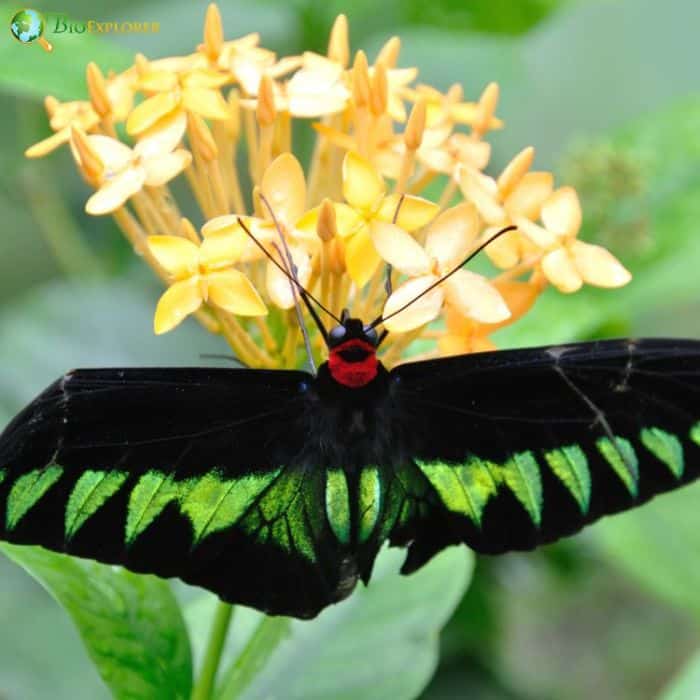
Rajah Brooke’s Birdwing, Trogonoptera brookiana, is a large and strikingly beautiful butterfly found in the rainforests of the Malay Peninsula, Borneo, Sumatra, and nearby islands.
Named after Sir James Brooke, the Rajah of Sarawak, this butterfly is an emblematic species known for its impressive size and vibrant coloration.
The wings of the Rajah Brooke’s Birdwing are predominantly black with striking green metallic bands and spots. The forewings are adorned with bright green markings, while the hindwings are black with iridescent green patches.
The body features a redhead and collar, adding to its vibrant and distinctive appearance. These bold colors serve both as a visual deterrent to predators and as an attraction for mates.
18. Blue Tiger
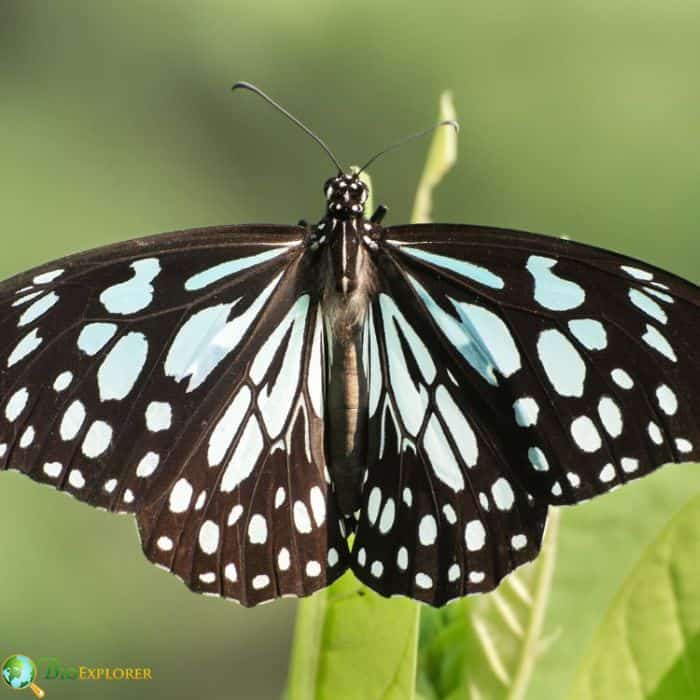
The Blue Tiger, Tirumala limniace, is a member of the Danaidae family, known for its striking appearance and migratory behavior. This butterfly is predominantly found in South and Southeast Asia, including India, Sri Lanka, and parts of Malaysia.
It thrives in tropical and subtropical regions and is often observed in gardens, forest edges, and coastal areas.
The wings of the Blue Tiger are primarily black with light blue streaks and spots arranged in intricate patterns. These blue markings are visually appealing and serve to deter predators by signaling the butterfly’s toxicity, which it acquires from feeding on specific host plants. The underside of the wings is paler, providing camouflage when the butterfly is at rest.
19. Ceylon Rose
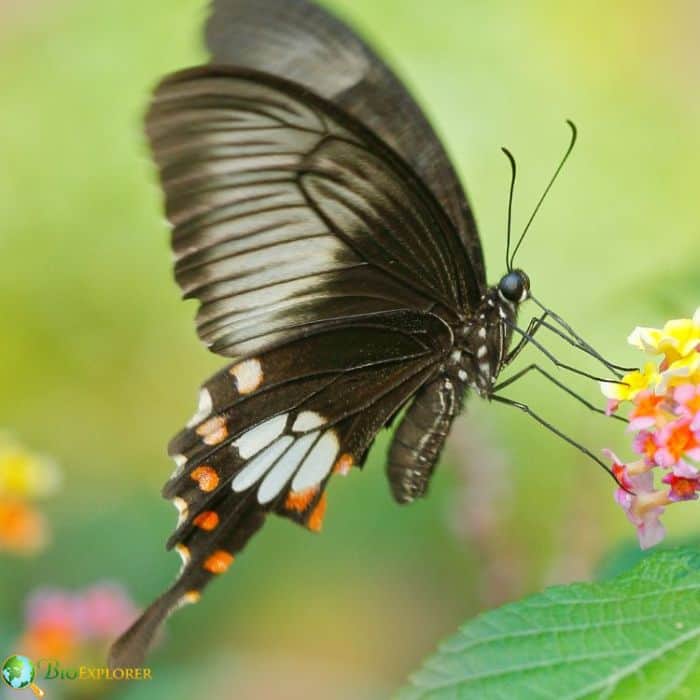
The Ceylon Rose, Pachliopta jophon, is an endangered butterfly species endemic to Sri Lanka. It belongs to the family Papilionidae and is recognized for its striking appearance and unique ecological role.
This butterfly is primarily found in the lowland wet zones of Sri Lanka, where it inhabits forested areas and is closely associated with specific host plants from the Aristolochiaceae family.
The Ceylon Rose displays a captivating coloration with its predominantly black wings accented by crimson red patches and white spots. The hindwings feature a series of red spots along the edges, while the body is marked with white stripes.
This vibrant coloration not only makes the butterfly visually stunning but also warns predators about its unpalatability due to the toxic compounds it accumulates from its host plants.
20. Scarlet Mormon
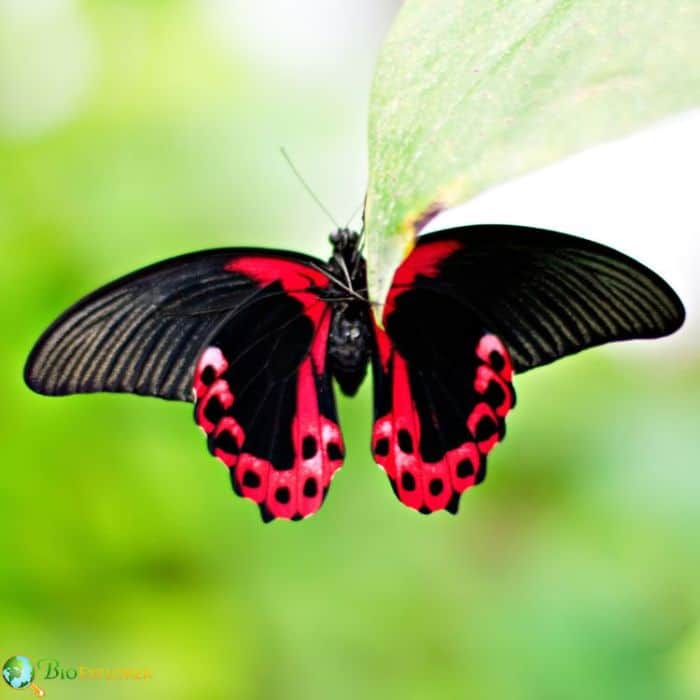
The Scarlet Mormon, Papilio rumanzovia, is a strikingly beautiful butterfly belonging to the Papilionidae family. Native to the Philippines, it is also found in parts of Southeast Asia.
This butterfly is known for its large size and dramatic coloration, making it a favorite among butterfly enthusiasts and a frequent sight in butterfly conservatories.
The Scarlet Mormon’s wings are predominantly black with vivid red patches on the hindwings, which are more prominent in males. Females exhibit more varied coloration, with possible white or yellow markings.
This sexual dimorphism in coloration serves as a visual delight and a mechanism for mate recognition and camouflage against predators.
21. Glassy Tiger
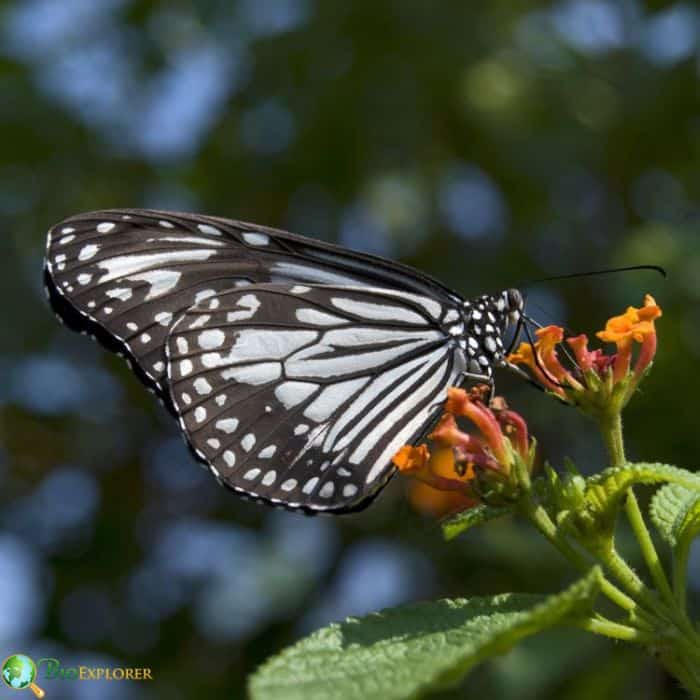
The Glassy Tiger, Parantica aglea, is a butterfly from the subfamily Danainae, known for its unique and striking appearance. This species is commonly found in South and Southeast Asia, including countries such as India, Sri Lanka, Thailand, and Malaysia.
It belongs to the group of butterflies known as the Crows and Tigers due to their distinctive coloration and patterns.
The wings of the Glassy Tiger are characterized by a translucent bluish-white ground color, with distinctive black lines and spots creating a striking contrast. The black markings outline the veins, forming a series of spots along the wing edges.
The combination of translucent white and black gives this butterfly a glass-like appearance, making it one of the more visually captivating butterflies in its habitat.
22. Jewel Beetle Butterfly
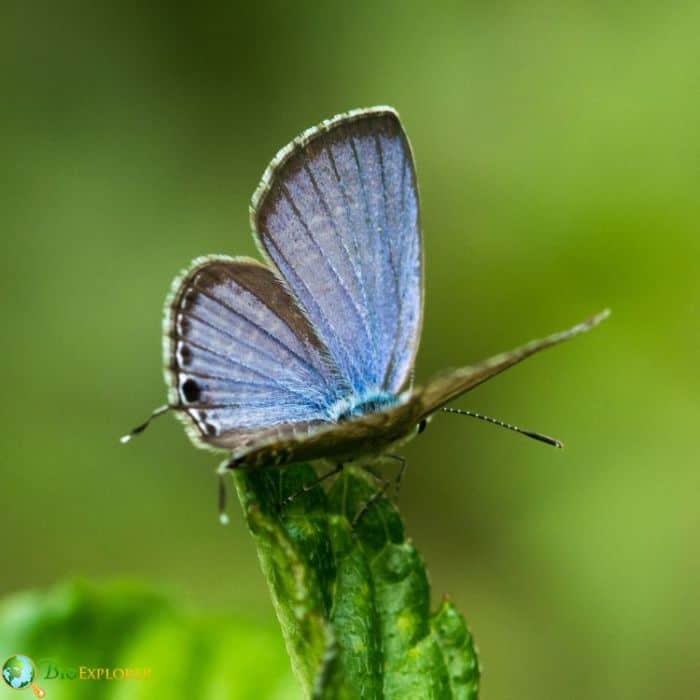
The Jewel Beetle Butterfly, scientifically known as Euchrysops cnejus, is a member of the Lycaenidae family, commonly referred to as the gram blue butterfly. It is widely distributed across the Oriental and Australian regions, including India, Sri Lanka, and Australia.
This species is known for its affinity to leguminous plants, particularly cowpea (Vigna unguiculata), which serves as its primary host plant.
The wings of Euchrysops cnejus exhibit a beautiful combination of colors. The upper side of the male’s wings is bright blue with a narrow black border, while females have a broader black margin.
The undersides of both males and females are pale brownish-grey with numerous small black spots and white-edged lines. This coloration provides excellent camouflage against predators when the butterfly rests with closed wings.
23. Indian Red Admiral
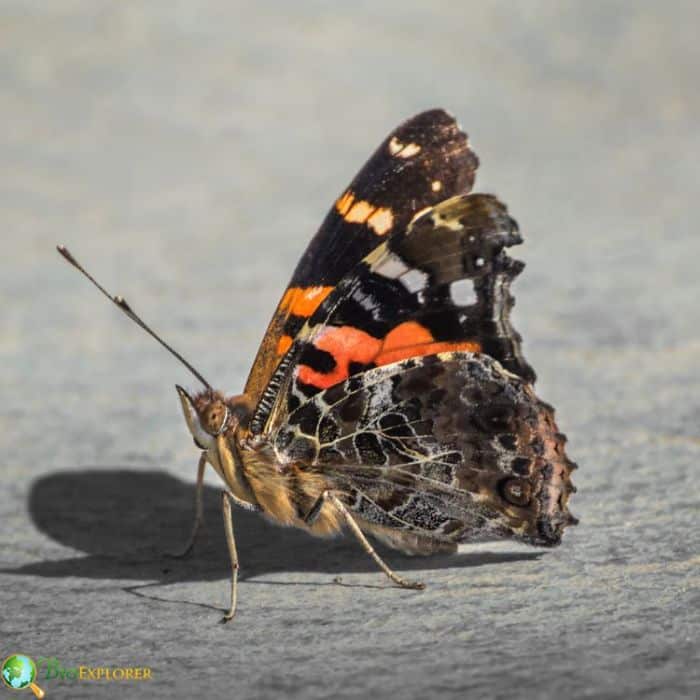
The Indian Red Admiral, Vanessa indica, is a butterfly species belonging to the family Nymphalidae. It is widely distributed across South and East Asia, including regions of India, Nepal, and Japan.
Known for its vibrant colors and unique behaviors, the Indian Red Admiral is a significant species for studying ecological interactions and evolutionary biology.
The Indian Red Admiral is known for its striking coloration. Its wings are black with bright red bands and white spots on the forewings. The hindwings are brown, with blue spots near the margins.
This combination of red, black, and white, along with the iridescent blue spots, makes the Indian Red Admiral one of the most visually appealing butterflies in its habitat.
24. Postman Butterfly
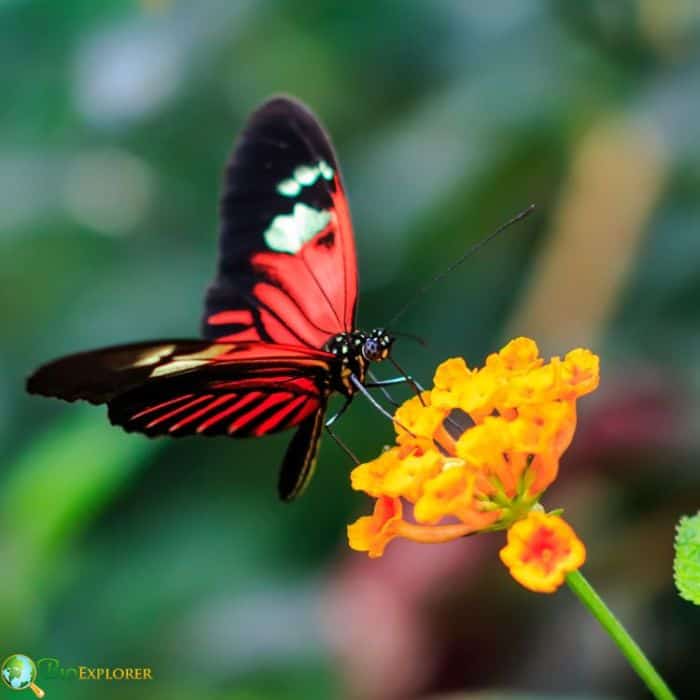
The Postman Butterfly, Heliconius melpomene, is a widely studied species of butterfly found in Central and South America. It is known for its vivid coloration and mimicry, which it uses to deter predators by signaling its unpalatability.
This butterfly has a remarkable Genetic diversity and exhibits various color patterns depending on its geographical location.
The wings of Heliconius melpomene are predominantly black with striking red or orange bands and white or yellow spots. These colors are not only visually appealing but also warn potential predators about their toxicity.
The bright red bands on their forewings and the distinctive patterns help in mimicry and camouflage, making them less likely to be eaten by Birds and other predators.
25. Green-banded Swallowtail
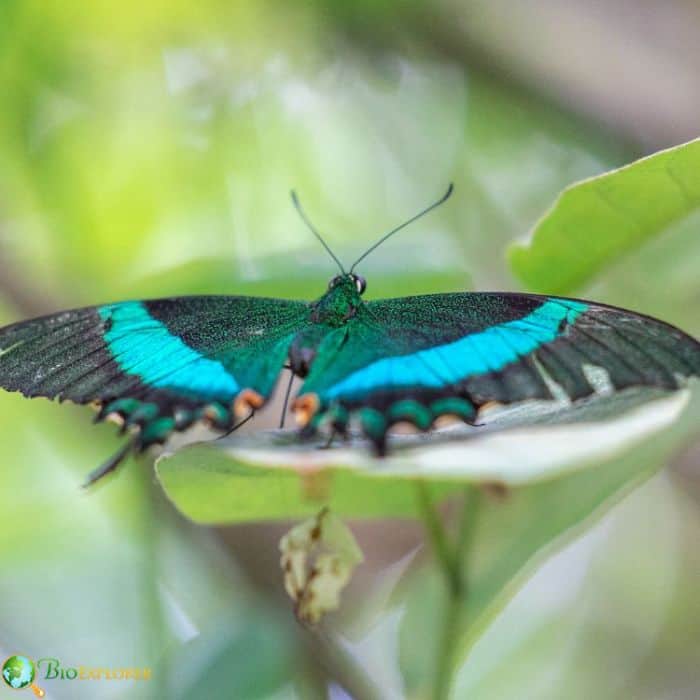
The Green-banded Swallowtail, scientifically known as Papilio nireus, is a striking butterfly species belonging to the family Papilionidae. It is predominantly found in sub-Saharan Africa, thriving in various habitats ranging from tropical rainforests to savannahs.
This butterfly is well known for its rapid and powerful flight, often seen fluttering around flowers and forest edges.
The species is recognized for its beauty and ecological importance as a pollinator and as part of the food web in its native regions.
The Green-banded Swallowtail’s wings feature a stunning array of colors, predominantly marked by vibrant green bands that contrast sharply against a black background. These bands are composed of scales that exhibit a blue-green fluorescence under certain lighting conditions.
This iridescence is due to papiliochrome II pigment within the scales, which enhances the visual appeal of the butterfly by reducing angle dependency and creating a consistent coloration.
Why Colorful Butterflies?
Colorful butterflies are visually stunning and serve essential purposes in their life cycles and ecosystems. The bright colors and intricate patterns on their wings are the result of millions of years of evolution, each hue and design playing a specific role in their survival and reproduction.
- One of the primary functions of colorful wings is to attract mates. Many butterfly species exhibit sexual dimorphism, where males and females have different colorations. Males often boast brighter and more vibrant colors to catch the attention of potential mates, while females may have more subdued hues to blend in with their surroundings and avoid predators.
- In addition to attracting mates, the colors of butterfly wings also serve as a defense mechanism. Some species, such as the Monarch Butterfly and the Postman Butterfly, have bold, contrasting colors that warn predators of their toxicity. These butterflies accumulate toxic compounds from their host plants, making them unpalatable to potential predators. Their bright colors act as a clear signal to birds and other animals to avoid them, thus increasing their chances of survival.
- Colorful butterflies also contribute significantly to the biodiversity of their habitats. As pollinators, they help to fertilize a wide variety of plants, including flowers, fruits, and vegetables. By fluttering from one bloom to another, they transfer pollen and facilitate plant reproduction, ensuring the continuity and diversity of flora in their ecosystems.
- Moreover, colorful butterflies serve as important indicators of environmental health. Their presence in an area can signify a balanced and thriving ecosystem, while their absence may point to ecological disturbances or Habitat Loss. Scientists often use butterfly populations to monitor the health of ecosystems and track the effects of climate change and human activities on the natural world.
The ecological importance of colorful butterflies extends beyond their role as pollinators and bio-indicators. They are also an integral part of the food web, serving as prey for birds, lizards, and other insectivores. The intricate relationships between butterflies and their predators help maintain their ecosystems’ delicate balance.
![]()



